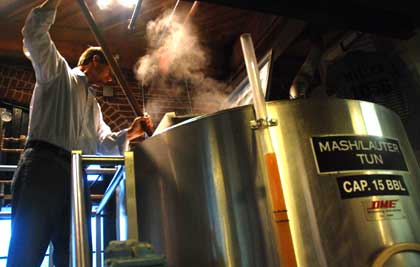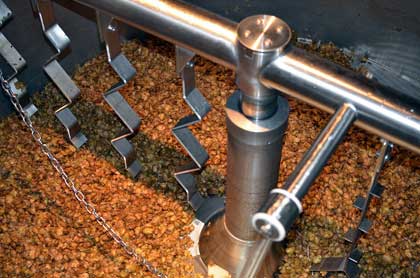
As Ron Pattinson is fond of pointing out, there’s little if anything truly new in beer. Not even “fresh hop” beers.
This weekend in St. Louis, 15 or so breweries will serve various beers at the Schlafly Fresh Hop Festival. We’re not Portland or Seattle (see this account), but Schlafly (otherwise known as The Saint Louis Brewery) flies in the fresh hops and the other breweries in and about St. Louis make what they will with them.
To get a feel for the trip to pick up the hops, read James Ottolini’s tweets. That’s him over the mash/lauter tun at the Schlafly Tap Room. To brew the fresh hop beer — the hops are Sorachi Ace — Brennan Greene and Stephen Hale turned the tun into a hop back. Ottolini, who oversees operations at Schlafly’s packaging brewery, Bottleworks, and various members of both brewery teams showed up the downtown brewhouse because, well, this was the first time they’ve tried this at Schafly and there’s always the chance something bad will happen and the story will become part of brewery lore. Brewers at Urban Chestnut Brewing (photo below, courtesy of Florian Kuplent) and Perennial Ales also used their tuns at hop backs while brewing beers to be served Saturday.

So there’s little efficient about the beers that will be served Saturday in St. Louis; not how they got here and not how they were made. Why bother? Been in a brewhouse when hops were added to the kettle? Smelled that aroma wafting into the air? Thought about where it is going? Away.
Same thing happens when hops are picked and dried (they must be dried relatively quickly, because otherwise they start to rot). Fresh. Green. That’s the smell of a hop kiln at harvest. More aroma lost forever.
Presumably these beers will deliver more of a grassy smack in the face — lemongrassy in the case of Sorachi Ace hops — than dried hops. They are more like grabbing a few cones right off the plant, rubbing them firmly between your palms and taking a deep whiff. A bold expression of the hop itself.
It’s worth remembering not everybody likes this, which must have been the motivation for a beer called Tempo that Blatz brewed more than 50 years ago. When Blatz president Frank Verbest announced the brewery would be testing the beer in 1955 he said that mildness and freedom from bitterness were what set Tempo apart.
Tempo wasn’t actually brewed with fresh hops, but instead an extract made from fresh hops. Otherwise, Blatz could have produced the beer only once a year. Verbest said the brewery spent two years and hundreds of thousands of dollar coming up with the process, partnering with companies outside the brewing industry. He likened it to distilling crude oil into gasoline and other derivatives. The efforts resulted in an extract which proved suitable for brewing beer without the bitterness common to hops, he said.
The Milwaukee Journal went into detail why Blatz pursued the project.
“The brewing industry, during the greatest boom in the country’s history is a sick business,” Verbest declared.
“Maybe Blatz has come up with the answer. This is the way we reason. Beer reached its peak in popularity during the period of unrestricted immigration just before World War I. Since the date the people have changed and their tastes have changed.
“For instance, the trend has been from bitter to sweet chocolate, from strong Turkish ciagrettes to mild Virginia ones, from strong cheeses to mild processed ones, from salty to mild butter.
“But while tastes have been changing, beer has remained the same. There has been a trend to use less hops, which give the sharper bitter taste to beer, but otherwise the change has been packaging.”
It’s not clear how long Tempo remained on the market. In 1958, a Milwaukee man sued Blatz, claiming they had not honored a 1954 deal in which he turned over his secret process for extracting the fresh hops. And in 1959, Pabst Brewing bought the Blatz label, along with Tempo and the rights to the process by which it was made. That deal was voided in 1969 because of anti-trust measures and G. Heileman Brewing acquired the Blatz brand. The Tempo name, related formulas, Tempo extract remaining in Pabst plants and Tempo bottles were all listed as assets.
It seems Tempo survived into the 1970s. However there turned out to be a better idea for fresh hopped beers.
“But while tastes have been changing, beer has remained the same.”
From 1914 (or 1918, if they’re referring more to the US involvement in WW1) to 1955 beer had remained the same? Hmm. Wonder what Maureen O. has to say?
“…claiming they had not honored a 1954 deal in which he turned over his secret process for extracting the fresh hops. And in 1959, Pabst Brewing bought the Blatz label, along with Tempo and the rights to the process by which it was made. That deal was voided in 1969 because of anti-trust measures …”
What ever happened to the extraction process rights?
Was it a hexane method? (That’d be my guess given the time in history.)
That’s a fascinating story, Stan. I do question whether a beer made from fresh-hop oil would taste the same as fresh hop beer–after all, dry hop oils don’t taste the same as regularly-hopped beer.
But, on the related issue of fresh-hop beers, I agree that the current flourishing must not be the world’s first. Indeed, I suspect historians can or will find reference to this going back hundreds of years. However, I would bet that it was never a major practice, because it takes SO many more fresh hops to produce flavor and aroma. Totally without evidence, I hypothesize that the practice would have happened sporadically, after especially abundant harvests.
But I’d love to hear from a reliable observer at the time.
Jeff – Sorry, I’m not that old. I wouldn’t be surprised if back in the day, before hops were cultivated, hops went directly from being picked being added to the beer. I could be reading Blatz’ intentions wrong, but it appears their goal was to avoid the this-is-hops character that I expect to tasted Saturday at Bottleworks.
There’s some more info (ads, articles) on Blatz’ TEMPO on my webpage at https://sites.google.com/site/jesskidden/jk%27smisc.beerpages/the-first-modern-wet-hop-beer
Blatz (as was common in that era) stressed TEMPO’s “lightness”. Two different can designs exist- one says “New Discovery Frees beer from harshness” and the other proclaims it “Lightest Beer ever”.
I rather doubt that “wet” hops were used in the “industrial” era of brewing (say, the 1800’s on). Literature at the time referred to them as “green” or “raw”, and hop histories usually note that hops were dried daily during the harvest, often on the hop farms themselves. (Before refrigeration, that was the most common method of preservation for many agricultural products, after all.) And, certainly in the US, most hop fields where still a distance away from the mostly urban-based breweries and mass transportation would have been via train than the more flexible trucks of today.
Stan, you must be right, though obviously, no amount of research in the world will unmask that mystery. If you are, I surmise that drying hops probably came when brewers realized they’d like to add those funny cone-flowers to their beer when they brewed in the spring, so they plucked some for saving and … voila!
Blatz Tempo. I’ll never forget it. Bought it by the case to have it after work (being a route man for Coca Cola in Milwaukee in the 50’s). Best tasting beer ever, and in that squatty bottle with the long neck…….Um-m-m-m Sure was good. If anyone ever brought it back again……it would make a Hit! Better that most of the “blandies” on the market now.